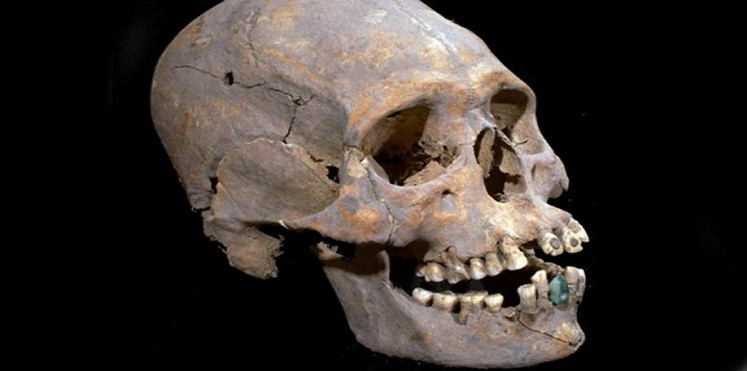Long skulls like aliens encrusted with gems in their teeth
Archaeologists found a woman's skeleton dating back to 1,600 years in Mexico with a skull that resembles aliens and teeth encrusted with gems.
Ancient Origins reported on July 8, Mexican archaeologists unearthed the tomb in the ancient ruins of Teotihuacan, 50 kilometers northeast of Mexico City. They discovered the skeleton dating back to 1,600 years of an upper-class woman with long skulls, encrusted teeth and a false tooth made of green serpentine stone. The 35-40 year old woman was buried with 19 burial jars.

Prolonged women's skull with teeth encrusted with precious stones was discovered in Teotihuacan, Mexico.(Photo: Ancient Origins).
The Mexican National Institute of Anthropology and History (INAH) said the skeleton was named "the woman of Tlailotlacan". Scientists predict that this woman is an immigrant foreigner, because the unusual stretched skull and gem-encrusted teeth are not found in other tombs in the region. Skull deforming techniques were born in southern Central America, not in central regions like Mexico.
According to anthropologist Velasco Archer, the ancients extended the skull by squeezing the head with wooden planks or wrapping tightly around the head from a young age. They do so because of the notion that deformed skulls show nobility, beauty or other values.
The teeth of the remains contain two round pyrite stones in the upper jaw. This technique is used in the Mayan aristocracy in southern Mexico and Central America. Maya people are masters of cosmetic dentistry. They decorate their teeth by attaching precious stones to their teeth or carving them on their teeth. Gemstones are attached to teeth thanks to natural resin adhesives, such as tree resins mixed with other chemicals and crushed bones.
Teotihuacan is one of the oldest and most important Mesoamerica cities with an age of about 2,500 years. The name Teotihuacan means "city of gods" in the Nahuatl language of the Aztecs. In 2015, scientists discovered liquid mercury in a tunnel beneath the Temple of Feathered Serpent in Teotihuacan. It could represent the underground river leading to one or more royal tombs.
- Why do medieval women have an alien-like skull?
- Detecting two mysterious skulls of aliens
- Discovering the portrait of gold encrusted angel where Jesus was born
- Ancient geese have hard teeth like bones
- Finding fossils of squirrels with ancient sword teeth
- Mars jewel contains fossils of alien creatures?
- Unexpected uses of metals and gems
- Mysterious decoding of children's skulls scattered around the lake in Switzerland
- Feed real teeth from cells
- Ancient Roman skulls under the Thames
- How to reduce pain when wisdom teeth grow
- Mysterious skulls appear in Syria
 Discovered an ancient centipede fossil 99 million years old
Discovered an ancient centipede fossil 99 million years old Discovered bat-like dinosaurs in China
Discovered bat-like dinosaurs in China Discovered a 200-year-old bronze cannon of the coast
Discovered a 200-year-old bronze cannon of the coast Discover 305 million-year-old spider fossils
Discover 305 million-year-old spider fossils Spain discovers teeth of 3 people who are not of our species
Spain discovers teeth of 3 people who are not of our species  Why many people grind their teeth while sleeping
Why many people grind their teeth while sleeping  How to choose the best toothpaste for your teeth
How to choose the best toothpaste for your teeth  The history of orthodontics, braces and interesting secrets that few people know
The history of orthodontics, braces and interesting secrets that few people know  The army of transforming robots helps clean teeth
The army of transforming robots helps clean teeth  Successful research on biomaterials stronger than spider silk
Successful research on biomaterials stronger than spider silk 